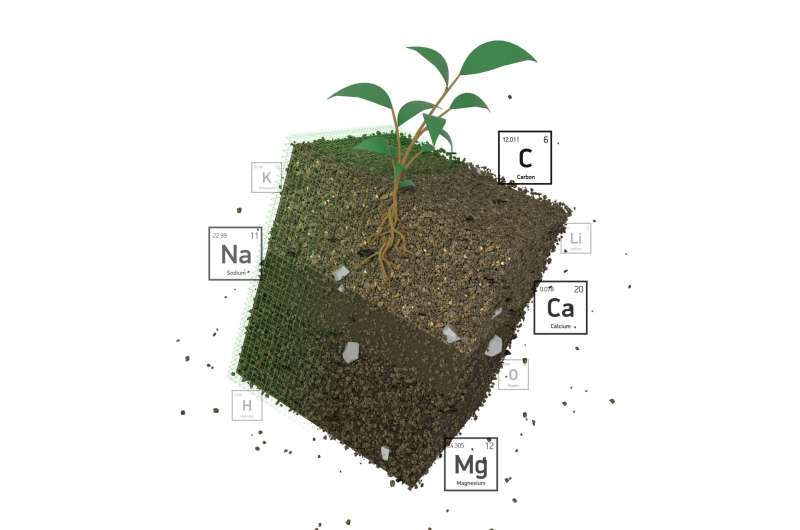This article has been reviewed according to Science X's editorial process and policies. Editors have highlighted the following attributes while ensuring the content's credibility:
fact-checked
trusted source
proofread
Scientists speed elemental investigations of plant growth, soil carbon storage

Enhancing plants' ability to pull planet-warming carbon dioxide from the atmosphere and store it belowground stably and sustainably is the aim of a team of scientists at the Department of Energy's Oak Ridge National Laboratory. They recently demonstrated use of a laser-based analytical method to accelerate understanding of critical plant and soil properties that affect bioenergy plant growth and soil carbon storage.
Researchers adapted a method that examines plasma light, called laser-induced breakdown spectroscopy, or LIBS, to quickly analyze the distribution of nutrient elements in the roots of the bioenergy crop, poplar. Their method, described in the journal Plant and Soil, provides key data in a fraction of the time with better spatial resolution than traditional analyses and with little or no preparation of root, stem and soil samples.
Because elemental nutrients such as nitrogen, iron and calcium influence carbon transformation and storage in soils, profiling elemental distribution in plant roots and soils more efficiently with higher resolution can provide insights into indicators and potential levers to enhance the amount of carbon locked away underground.
"This method speeds analysis and addresses data gaps, accelerating our ability to optimize plant performance and soil management practices that are conducive to enhanced carbon sequestration capacity belowground," said ORNL's Udaya Kalluri, a plant systems biologist working to develop crops with enhanced aboveground growth and belowground carbon storage.
Unlocking the black box
Kalluri describes the underground world as "a black box" in comparison with the amount of knowledge available about aboveground plant processes. DOE's Center for Bioenergy Innovation at ORNL, one of four Bioenergy Research Centers across the nation, has contributed new knowledge and innovations over the last 15 years focused on improving the growth and yield of bioenergy crops. Many other institutions have contributed to that effort as well, with most of the research focused on aboveground plant traits.
Belowground plant-soil interactions that could improve biological carbon storage are comparatively understudied, and Kalluri is energized by opportunities to collaboratively develop measurement technologies to help close these knowledge gaps.
"There's an urgent need for techniques to measure better and faster to fill those gaps that exist in our understanding of spatial-temporal variability of plant roots and soil systems," Kalluri said.
The incredible diversity and complexity of underground systems poses a challenge. Root systems vary in architecture, anatomy and chemistry. Soil composition differs widely in moisture content, acidity, elemental composition, structure and microbial populations. These factors can vary tremendously at different soil depths and even among neighboring plots of land. Better understanding the influence of these factors on soil carbon storage requires more data.
"Having sparse and poorly resolved data has limited our ability to predict and optimize plant performance and potential carbon sequestration capacity of plant-soil systems," Kalluri said.
Enter Madhavi Martin, a LIBS expert and lead for the Biomaterials and Biomass Characterization group at ORNL. Martin has pioneered the use of LIBS for evaluating biological samples over the last 20 years. In this study, the team demonstrated the use of LIBS on fresh plant roots and soil samples. Previous methods required drying plant samples and grinding them into powder in a time-intensive process that yielded less detailed information on the location of nutrients.
With this new approach to LIBS, processing hundreds to thousands of samples from a few field sites becomes more realistic and efficient.
"Being sensitive to nearly every element in the periodic table and providing an elemental signature of a sample in milliseconds makes LIBS a very attractive technique for examining large volumes of samples," said ORNL researcher Hunter Andrews, a LIBS expert and the first author on the publication.
"By comparing these elemental signatures with datasets of genetic variations in poplar, we can determine the function of genes that use certain elements," Martin said. "These new insights can help optimize plant-based carbon sequestration and advance our understanding of biomass properties that are conducive to bioenergy production."
ORNL's Ann Wymore also contributed to the paper, titled, "Rapid in situ nutrient element distribution in plants and soils using laser-induced breakdown spectroscopy (LIBS)." This research was conducted through the Center for Bioenergy Innovation. CBI is accelerating the development of bioenergy-relevant plants and microbes to enable production of drop-in sustainable aviation fuel, bioproducts that sequester carbon and sustainable replacements for plastics and other environmentally harmful products.
More information: Hunter B. Andrews et al, Rapid in situ nutrient element distribution in plants and soils using laser-induced breakdown spectroscopy (LIBS), Plant and Soil (2023). DOI: 10.1007/s11104-023-05988-7
Provided by Oak Ridge National Laboratory





















